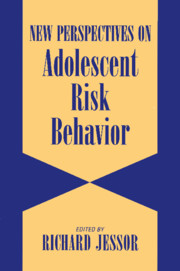Book contents
- Frontmatter
- Contents
- List of contributors
- Preface
- 1 New perspectives on adolescent risk behavior
- Part I A focus on development
- Part II A focus on problem behavior
- 3 Persistent themes and new perspectives on adolescent substance use: A lifespan perspective
- 4 Multiple risk factors for multiproblem boys: Co-occurrence of delinquency, substance use, attention deficit, conduct problems, physical aggression, covert behavior, depressed mood, and shy/withdrawn behavior
- 5 Adult outcomes of adolescent drug use: A comparison of process–oriented and incremental analyses
- 6 Linking etiology and treatment for adolescent substance abuse: Toward a better match
- 7 Risky driving behavior among adolescents
- Part III A focus on sexual activity
- Part IV A focus on psychopathology
- Part V A focus on social role performance
- Part VI Overview and integration
- Author index
- Subject index
4 - Multiple risk factors for multiproblem boys: Co-occurrence of delinquency, substance use, attention deficit, conduct problems, physical aggression, covert behavior, depressed mood, and shy/withdrawn behavior
Published online by Cambridge University Press: 06 July 2010
- Frontmatter
- Contents
- List of contributors
- Preface
- 1 New perspectives on adolescent risk behavior
- Part I A focus on development
- Part II A focus on problem behavior
- 3 Persistent themes and new perspectives on adolescent substance use: A lifespan perspective
- 4 Multiple risk factors for multiproblem boys: Co-occurrence of delinquency, substance use, attention deficit, conduct problems, physical aggression, covert behavior, depressed mood, and shy/withdrawn behavior
- 5 Adult outcomes of adolescent drug use: A comparison of process–oriented and incremental analyses
- 6 Linking etiology and treatment for adolescent substance abuse: Toward a better match
- 7 Risky driving behavior among adolescents
- Part III A focus on sexual activity
- Part IV A focus on psychopathology
- Part V A focus on social role performance
- Part VI Overview and integration
- Author index
- Subject index
Summary
Researchers have not been in agreement about whether to consider all juvenile problem behaviors as sufficiently similar to be covered by a single construct. Some have advocated a general deviance or problem construct (e.g., Donovan, 1996; Donovan, Jessor, & Costa, 1988; Jessor, Donovan, & Costa, 1991; Jessor & Jessor, 1977; Kaplan, 1980; Patterson, Reid, & Dishion, 1992; Robins, 1966), whereas others have advocated a more differentiated approach (e.g., Loeber, 1988; McCord, 1990; McGee & Newcomb, 1992; Osgood, Johnston, O'Malley, & Bachman, 1988). Some have distinguished between types of externalizing problems – for example, covert or property offenses versus overt or person-related offenses (e.g., Frick et al., 1993; Loeber, 1988; Loeber & Schmaling, 1985a), but others have focused on externalizing problems or delinquency in general (e.g., Hirschi & Gottfredson, 1983; Patterson, 1982). Some researchers have made a distinction between externalizing problems or delinquency and substance use (Loeber, 1988; White & Labouvie, 1994), but others have maintained that they represent the same underlying construct (e.g., Elliott, Huizinga, & Ageton, 1985; Jessor & Jessor, 1977; Pulkkinen, 1983). Few researchers have investigated the extent to which externalizing, attention deficit/hyperactivity, and internalizing behaviors (such as depressed mood and shy/withdrawn behavior) can be best captured by a single-problem approach. Also, whereas sociological investigators have ignored attention deficit and hyperactivity as possible components of a general problem syndrome, they have been more strongly stressed by psychiatrists and psychologists (Hinshaw, 1987).
Information
- Type
- Chapter
- Information
- New Perspectives on Adolescent Risk Behavior , pp. 90 - 148Publisher: Cambridge University PressPrint publication year: 1998
Accessibility standard: Unknown
- 97
- Cited by
